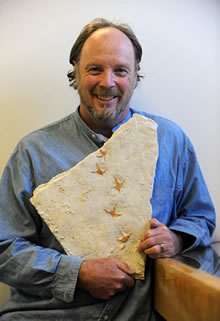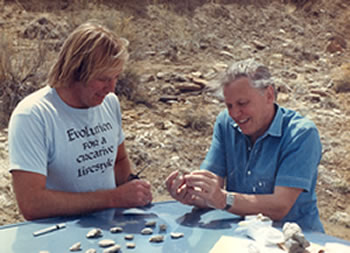|
Martin teaches General Paleontology, Sedimentology and Stratigraphy, Dinosaurs, Ichnology and the Evolution of Consciousness. He is advisor to graduate students at CU and other institutions. He is the author of more than 650 papers books, book reviews, reports and abstracts on paleontology, geology and evolution, including more than 500 on fossil footprints. Books and edited volumes include Dinosaur Tracks and Traces (Cambridge, 1989, with D.D. Gillette), Volcanism and Fossil Biotas, (Geol. Soc. America, 1990, with A. Rice), Tracking Dinosaurs (Cambridge, 1991), Dinosaur Tracks and other fossil footprints of the western United States (Columbia, 1995, with A. Hunt), The Eternal Trail (Perseus, 1999), Dinosaur Tracks and other fossil footprints of Europe (Columbia, 2000, with C. Meyer), A guide to Fossil Footprints of the World (Dinosaur Ridge, 2002, with J. Peterson) and How Humanity came into Being: the evolution of Consciousness (Floris Books, 2010) His research has taken him to the Colorado Plateau region/western North America, South America (Bolivia), Europe (Portugal, Spain, U.K., Switzerland, Germany, France) east Asia (Japan, Korea, China) and Central Asia (Uzbekistan). Creator and director of the Dinosaur Tracks Museum (UC Denver) in 1996, he designed the international Tracking Dinosaurs exhibit, which traveled to 24 venues in Asia, North America and Europe between 1991 and 1999. He was formerly Board and Executive committee member for the Friends of Dinosaur Ridge, a 501C.3 non-profit organization. He’s active in local conservation of fossil sites and in preparation and evaluation of UNESCO World Heritage proposals "The ‘trackers’ began researching tracksites in Colorado and Utah in the 1980s, and have continued to be very active in our ‘home’ states to this day . In the early 1990s, we also turned to sites in east Asia, especially on the picturesque south coast of Korea. We also conducted a study of modern tracks at Lake Manyara in Tanzania. In the 1990s we worked with ropes on the cliffs of Portugal and in the Jura mountains of Switzerland, and made a National Geographic sponsored expedition to central Asia (Uzbekistan and Turkmenistan), to the world's longest trackways (1020 ft) made by a late Jurassic carnivore. In 1998 we joined a Swiss expedition to Andes of Bolivia to the world’s largest tracksite (a vertical wall 200 feet high and a mile long), and we restudied important tracksites in the U. K. Spain and Germany. In the 2000-2009 decade we conducted many studies in China, Thailand and Korea, and expanded our scope from Dinosaur tracks to the study of pterosaur and bird tracks. We also made extensive studies of ancient mammal, bird and hominid tracks and discovered and documented new sites in Mexico and Nicaragua. "The collection, which is arguably the world's largest and best documented, consists of more than 2,400 tracks (originals and replicas) of all ages from Carboniferous to Recent), a large number of which have been illustrated in several hundred scientific publications. The collection includes more than 75 type specimens of ceratopsian and champsosaur tracks (Ceratopsipes and Champsosaurichnus, from Golden, CO), Stegosaur tracks (Stegopodus, from eastern Utah), the first described Tyrannosaurus track (Tyrannosauripus from New Mexico), the first large two toed raptor tracks (Dromaeopdus from China), a large number of bird and pterosaur tracks new to science and the ancient human track Hominipes." |
At some point in life most of us ponder our origins and that of our species, life and the universe in general. Paleontologists traditionally study aspects of the "history of life." Some focus on the origins of unicellular life, others on invertebrate animals, yet others on vertebrates, including mammals and our primate ancestors. There is no firm dividing line between these deep-time ruminations and more 'recent' anthropological explorations of the origins of Homo sapiens, language and culture. In fact, it is we humans who have created modern scientific disciplines of Astronomy/Physics, Chemistry, Biology/Evolution and psychology/consciousness studies. Not by coincidence the emergence of these disciplines follows an intellectual 'history of science' sequence that mirrors our scientific explanation of the evolution of the universe, from Physiosphere to Biosphere to Noosphere (matter > life > mind). What role, we may ask, does our evolving consciousness (self-awareness) play in fundamentally affecting the way we view the universe and our place in it? The photo below is a somewhat younger Dr. Lockley in the field with David Attenborough.
So a bird is a pretty evolved organism. But have you ever knocked out a housefly? It's easy to do, just catch one in your hand and swing it toward the ground and release it. They can be inert for minutes, then get up, shake their...whatever it is they shake, and take off. Does that mean flies have consciousness? Is it qualitatively different from ours, or just quantitatively (if that)? Incidentally, though experts say they don't believe a word of it, Julian Janes' book The Origin of Consciousness in the Breakdown of the Bicameral Mind is one of the best-written, intelligent, and thought-provoking books on the mind that this editor has read. Oh, and remember that much of Dr. Lockley's work is on fossil bird and other old beast tracks. Recently, the extraordinary site at Dinosaur Ridge just west of Denver has been in the news, as it is eroding due to weather (is climate change involved?) and may within a few years be gone if it is not protected. He has been widely quoted in the press. The issue seems to be that the local government does not want to allow the construction of a protective structure, as it may "spoil the view." Does this remind anyone of the talk Martin's colleague Dr. Charles Musiba gave at Café, about trying to protect the Laetoli footprints? We are sure Dr. Lockley will be willing to discuss this situation too.
|

 Martin G. Lockley (BSc Geology, Queens University, Northern Ireland, 1974: PhD, Birmingham, U.K., 1977, BA Spanish, CU Denver) is a Professor of Geology at the University of Colorado Denver and Director of the Dinosaur Tracks Museum.
Martin G. Lockley (BSc Geology, Queens University, Northern Ireland, 1974: PhD, Birmingham, U.K., 1977, BA Spanish, CU Denver) is a Professor of Geology at the University of Colorado Denver and Director of the Dinosaur Tracks Museum.  The Café editor adds: OK, what actually is consciousness? We have an idea of what our own consciousness is like, because we live in it, but where does it live? I have been struck by the interesting fact that almost any creature I've observed must be conscious, because it can lose consciousness. I once heard a noise at my window and went out to discover a goldfinch that had flown into it and knocked its little lights out. He lay on the ground like a boxer, breathing and occasionally twitching, and I sat with him lest a squirrel or other carnivore should visit while he was at a disadvantage. After about 20 minutes he shook his head just the way I would, got shakily to his feet, looked at me thoughtfully, and took off.
The Café editor adds: OK, what actually is consciousness? We have an idea of what our own consciousness is like, because we live in it, but where does it live? I have been struck by the interesting fact that almost any creature I've observed must be conscious, because it can lose consciousness. I once heard a noise at my window and went out to discover a goldfinch that had flown into it and knocked its little lights out. He lay on the ground like a boxer, breathing and occasionally twitching, and I sat with him lest a squirrel or other carnivore should visit while he was at a disadvantage. After about 20 minutes he shook his head just the way I would, got shakily to his feet, looked at me thoughtfully, and took off.